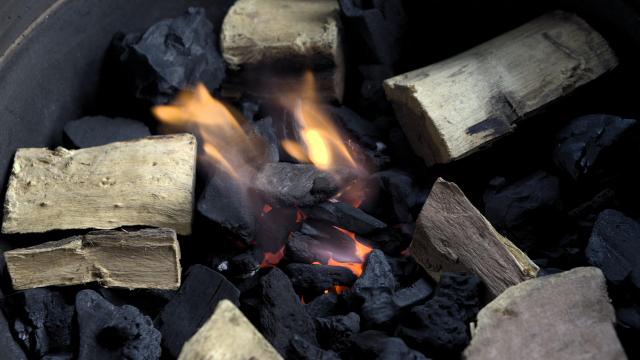To grill is human, but to smoke is dad-like. Smoke is the so-called “third leg” of BBQ. It adds flavour, and helps build that sought after bark, and is what makes BBQ taste like BBQ. To make smoke, you need to burn some wood (or pellets), and nearly every smoking tutorial will tell you that the wood chips or chunks should be soaked in water before being tossed on the flames.
I have never done this.
The first time I neglected to soak my wood, it was because I forgot. My pork shoulder came out pretty freaking good anyway, without any soaking, so I didn’t see a reason to change my ways. I didn’t soak my wood when I smoked this turkey or this lamb, and both of those were also delicious.
But still, I wondered if I was missing something by not soaking my chips and chunks. Was my smoke too aggressive? Would I get a better flavour with wet wood? To answer these questions, I went to AmazingRibs.com, which always has the answers to my grilling and smoking queries and musings.
It turns out, not soaking your wood is totally fine. According to Meathead — who soaked, weighed, and cross-sectioned several pieces of wood — water doesn’t penetrate that far into hardwood (the kind of wood you should be smoking with):
To see just how far water penetrates into wood, I soaked three pieces of wood for 24 hours in a mix of water and blue food colouring. I then rinsed the surfaces and patted them dry with a paper towel. I photographed the exteriors. I then cut the wood in half and photographed the interiors. As you can see from the pictures at the top of the page, the dye discolored the surface only a little, mostly where there is peach-fuzz from the cutting and chipping process, and water and the dye entered the interiors only where there were cracks and fissures. The rest of the wood is bone dry.
Then there is the matter of steam and heat. Wet wood can only get so hot. Water boils of at 100°C, which means your wood won’t get much hotter than that until all the steam escapes. This can, in turn, lower the temperature of your coals. If you’ve done a lot of extended cooking on a charcoal grill, you know that temperature control is a big part of getting consistent, dependable results:
Let’s say the coals or gas jets are 315°C on their surface. If the wood surface is wet the wood cannot heat much beyond 100°C, water’s boiling point, until it evaporates by turning to steam. The wood’s surface temp sticks at 100°C. After the water is driven off, the wood starts to warm and when the surface hits the combustion point, about 300°C, it begins giving off gases. It can then combust and produce smoke.
Also, the whole point of putting wood on hot coals (or in your gas grill set up) is to get that wood to burn and give off smoke. If you’re worried about your wood “burning too fast” just use smaller chips and spread them out a bit. (If you know me, you know I am a big fan of the charcoal snake for this reason.) According to Meathead, blue smoke is “the best tasting smoke” and “is practically invisible, thin, and pale blue. Blue smoke is better than white, grey, or black, by far. Blue smoke needs dry wood and a hot fire, lots of oxygen and flame.”
I was right to be lazy and forgetful, is what I’m saying, and you should feel emboldened to be lazy and forgetful, too. (At least about this one thing; your mileage may vary in other sectors of your life.)

Leave a Reply
You must be logged in to post a comment.